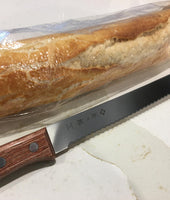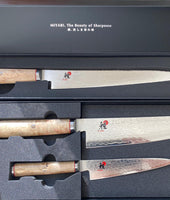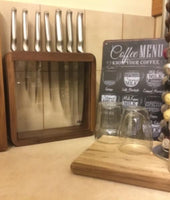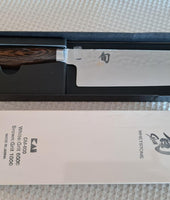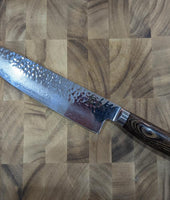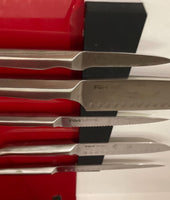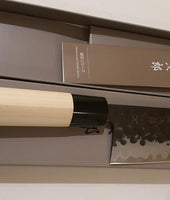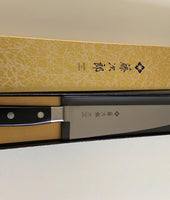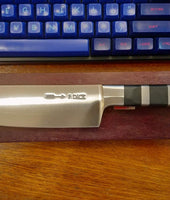The Japanese cuisine often calls for specialist knives. Anywhere else, this might have been a problem, but given the country's tradition in blade making starting from the famous katana swords, there are plenty of them. Given the country's heavy preference for veggies, a specialized knife for the function is necessary, and the Japanese have several, including the Usuba and the Nakiri knife.
What is a Nakiri Knife?
Nakiri means leaf cutter in Japanese, and this is the knife's specialty, to mince, chop, dice, and slice vegetables. Its broad rectangular blade characterizes it with a flat and blunt tip which is often rounded and not pointed. Besides vegetables, a Nakiri knife is also excellent for cutting fruits. Cutting vegetables is one of the most common tasks in the kitchen or meal prep. For this reason, the nakiri knife is recommended for any chef as part of a complete knife set.
Its design will not work for precise cuts or rocking cutting techniques like the santoku or the gyuto. However, it gives it efficiency cleanly cutting vegetables and fruits because you are making use of the whole cutting surface. Besides, not having a rounded tip protects the knife's blade; the tip of the knife is what makes the first contact with the chopping board. If it was pointed or squared, it would damage the knife.
Features of a Nakiri Knife
You can tell a nakiri knife based on several standout features. The main ones include;
Its shape and size
Nakiri knives are long and rectangular, measuring anywhere from 120mm to 210mm. However, most people prefer the ones that measure 165mm or 180mm. The tall length of the knife provides excellent knuckle clearance that improves your comfort as you use the knife. Further, its rectangular shape gives it a unique advantage in that even as you sharpen the blade, its length remains the same, unlike the knives with curved blade edges like the santoku or the gyuto.
On top of having a rectangular shape, the blade has a straight cutting edge. This design makes it excellent for a vertical up and down cutting motion. Its long length also enables you to quickly cut vegetables in a single downward movement. Its thin blade, on the other hand, ensures you have clean cuts without ripping the vegetable.
The length of breadth of the blade also allows for easy chopping of hardy vegetables like tubers and squashes. However, you should not confuse a nakiri knife with a cleaver as the latter, while similar in shape, has a thicker blade to handle heavier work. It is not recommended to use the nakiri to cut through bones or frozen food.
Type of edge
The nakiri knife is a double beveled knife that is unlike its closest compatriot, the usuba knife. A double bevel means the blade is ground on all two sides, giving it a balanced cut and giving you acute cuts. It also allows both right and left-handed users to use the knife, unlike a single bevel knife that will need a left-handed chef to get a separate knife, often at a higher cost.

Miyabi Birchwood 5000MCD Nakiri Vegetable Knife 17cm
The handle
The handle plays an important role in your comfort and the speed with which you cut your food. It also impacts the balance and aesthetics of the whole knife. Nakiri knives usually have two main types of handles, the Japanese 'wa-handle' or a western-style kind of handle. Most Japanese nakiri knives feature a 'wa-handle' type of handle. These come in different shapes too, either octagonal, D-shaped, or oval. Your choice of the handle will come down to preference, but it helps to pick an ergonomic handle for safety and comfort.
Advantages of a Nakiri knife
So why should any chef choose to use a nakiri knife in the kitchen for cutting vegetables? Well, there are several benefits the nakiri gives, which include;
It gives you thin and even slices:
Any chef wants thinly cut vegetables, and the nakiri knife gives you this thanks to its flat and thin blade. It also allows you to maintain consistency in your cuts, giving you even slices, especially when you want to decorate your salads or have ribbon cuts.
Fast and fluid chopping
A simple motion is all you need to cut through the vegetables. There is no pulling or pushing horizontally, nor do you need a rocking motion. Not only does this allow for fast cutting it also prevents the vegetables from sticking together as you cut the vegetables, especially onions and celery. The nakiri knife's flat blade goes through the vegetables through to the chopping board.
It is excellent for delicate vegetables.
If you are cutting soft veggies, there is a fear of squashing them and thus damaging them. However, the thing and flat profile of the knife gives you the precision you need to chop the delicate vegetables without damaging them.

Shun Kai Classic Nakiri Vegetable Knife Left-Handed 16.5cm
It has the right length size.
The nakiri knife has a length of 5-7 inches on average. This is a generous length that allows the nakiri to handle any kind of vegetable or fruit without the need for making frequent repeat cuts.
It has a double bevel.
The double bevel edge on nakiri knives means they are inclined on both sides. This feature makes them ideal for veggie cutting since it facilitates straight cutting, which is what you want when looking for a motion that is easy to repeat.
It is usable from tip to tail.
Because it does not have a pointed end, you get to use the blade's whole surface, which increases your efficiency. Ease of cutting and efficiency is what you want from the best vegetable knives, and a nakiri delivers that in spades.
What to look for when buying a Nakiri knife
While nakiri knives are the best for vegetables, it does not mean that any you get in the market is the best. There are several factors you should look for, including the following;
- Type of steel
- Type of handle
- The price
- Blade finish
Under types of steel, you generally have two options. Either go for carbon steel or stainless steel. These two kinds of steel determine the knife's edge retention, susceptibility to corrosion and rust, and overall durability.
If you pick carbon steel, you get knives that are easier to sharpen and can hold their edge for longer. They, however, demand high maintenance as they are susceptible to rust and corrosion. Stainless steel has higher durability, is resistant to corrosion and rust, and does not chip easily. However, they are harder to sharpen and get dull faster.

Wusthof Classic Series Nakiri 17cm
The compromise is to find the high carbon stainless steel, which offers the best of both worlds but often comes at a premium price.
When you consider the knife's handle, it comes down to preference and how you use your knife. If you grip your kitchen knives by the handle, you should use a nakiri knife with a shaped or western-style handle. On the other hand, if you use a pinch grip, the best option is the traditional Japanese style for handles, 'wa-handle.'
Regarding price, it depends on your budget though any chef knows the best knives will have a premium cost. The price often denotes the quality among specialist knives, so you should be prepared to spend anywhere from $100 to $200 and more for the best nakiri knife. It helps to look for stores with sale or discount coupons to get the best knife but still stay within your budget.
Finally, the blade finish is another factor to consider because vegetables tend to stick on knives when you cut them. The best nakiri knives come with a hammered finish traditionally known as tsuchime finish to avoid this issue. The hand-hammered finish reduces drag when you are cutting, so the vegetables will be less likely to stick. You can also get a nakiri that has a Granton edge as it has the same effect.
Best Nakiri knives
There are several options for the best nakiri knives in the market. You could start with the Miyabi 5000FCD Nakiri Vegetable Knife. It is 17cm long with full tang and provides excellent quality with its ergonomic handle, Damascus steel, and traditional Japanese honing, leading to a 19°symmetrical blade. It also holds its edge longer and has a beautiful sleek design.
You can also choose the Tojiro Traditional Pro Series Nakiri Chopping Knife. It has a blade 160mm long and a total length of 300. The knife is handcrafted in Japan and uses magnolia wood for the handle. It also uses high-quality and polished molybdenum-vanadium compound steel.

In Conclusion
Nakiri knives are the best when it comes to cutting vegetables and fruits. The challenge for most people, though, is finding where to purchase them.
At House of Knives, we have the advantage of stocking the best knives from the best manufacturers globally. Shop our range of Nakiri knives here.
Also Read: Fun Facts About Large Plastic Cutting Boards Australia
Explore our other products: F DICK 1905 Series Utility Knife Serrated Edge 26cm, F DICK 1905 Series Utility Knife Serrated Edge 32cm, and F DICK ActiveCut Boning Knife Flexible 15cm.


























